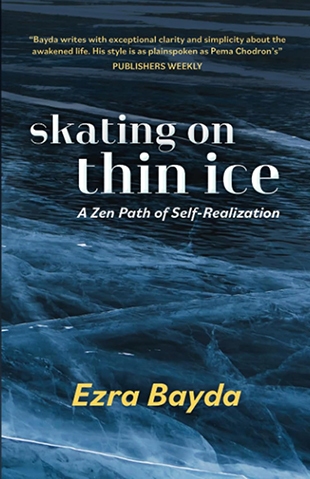Ezra Bayda is profiled in S&P’s Living Spiritual Teachers Project, and five of his seven books have received S&P Awards as Best Spiritual Books of the year. Calling himself a “practical philosopher,” he writes from his own experiences, presenting spiritual practices he has found useful in daily life. We’ve admired that aspect of his teachings for years and were happy to see some of our favorite themes and practices show up in this book as well. He calls it “the summation of my fifty-five-year-long spiritual journey.”
He begins by pointing out what most of us would prefer not to think about: we are all vulnerable and at the mercy of uncertainty; we are skating on thin ice. But if we are on the path of self-realization, then we must realize that our difficulties are not obstacles – they are the path itself.
Bayda tells wonderful stories throughout the book (he even admits to making up some of them), and one in particular struck home with us. A farmer went to the Buddha and told him all about his problems. The Buddha said, “I’m sorry, but I can’t help you.” The farmer was shocked. He had heard the Buddha was a great teacher. The Buddha explained: “My teaching can’t help with the eight-three problems, but perhaps it can help with the eighty-fourth problem. . . . The eighty-fourth problem is that we don’t want to have any problems.”
We need to make a fundamental change in our orientation to life toward a willingness to just be with whatever we meet. To do this, Bayda recommends practices such as self-observation (observing ourselves objectively in all kinds of situations) and being in the present moment (avoiding analyzing, blaming, and judging). Qualities such as perseverance and curiosity help.
Bayda is especially good at posing questions; reflecting upon them, we often find ourselves encouraged to try a spiritual practice. Five essential questions are:
1. What is going on now?
2. Can I see this as my path?
3. What is my most believed thought?
4. What is this?
5. Can I let this experience just be?
Other questions: How do I think it’s supposed to be? What’s blocking happiness right now? Can we see how attached we are to our self-image and identity? What is it that each of us brings to [our] relationships that seems to cause so many problems? What is my life really about?
He has 20 small cards on which he has written the name of someone he is close to, a closely held identity, a favorite activity, or some other aspect of his life. Every couple weeks, he shuffles the cards and picks one. He asks himself, “What would it be like if I were to never have this in my life again?”
Bayda likes lists and he provides some good ones here: “Ten Guidelines to True Contentment” and “Answers to the Question, ‘What is the Path of Self-Realization?’ ” (see excerpt). In a chapter on “Conscious Living,” he covers conscious eating, conscious talking, conscious sleeping, conscious meditating, and a conscious pause.
Bayda unfolds layers of insights into the path of self-realization, and we found that just looking at the book’s table of contents was a good place to start on any day. What does he have to say about detours and strategies, happiness, gratitude, generosity, attachment, kindness, grief, anger, fear, pain and suffering, relationships, letting be, living genuinely, death as an advisor, and getting older? Get this book and savor his wisdom on these and other topics!
